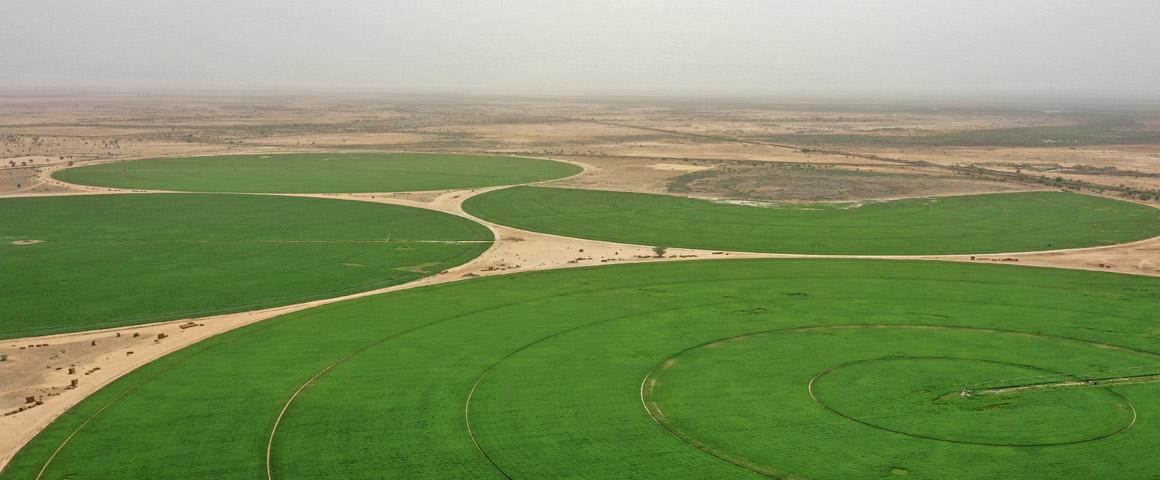Results & impact 10 October 2025
- Home
- Press area
- Press releases
- Agricultural land acquisitions in Senegal
Senegal: the challenge agricultural land acquisitions pose for land observatories

Fodder crops being grown with centre-pivot irrigation in the Senegal River delta © Mohamadou Dieye - ISRA BAME
Since the late 2000s, the land rush on the part of foreign investors has left many Senegalese smallholders by the wayside. In a country where agriculture, the leading employment sector, provides almost 70% of the national labour force with jobs but contributes little to GDP, the State looks kindly on the arrival of private investors such as agro-industry, to foster economic development.
“As far as civil society is concerned, the impression that land is being grabbed is growing, particularly since some investments are intended to guarantee food security in countries such as Saudi Arabia, which have fewer resources and less competitive labour costs”, says CIRAD geographer Jérémy Bourgoin.
Several groups and ministries rely on observatory-type structures to measure the impact of draft policies and political orientations on rural areas. CIRAD is helping a network of partners, including the Institut sénégalais de recherches agricoles (ISRA), gather and process data on large-scale land investments, hence fuelling public debate. Observatories are intended to improve land and resource governance.
Pinpointing the dynamics of large-scale land acquisitions
In partnership with the Observatoire national de la gouvernance foncière (national land tenure governance observatory) in Senegal, three main categories of land transaction players have been identified: Senegalese smallholders, who practise traditional cultivation on inherited land, local religious, political or economic elites, who are starting to show an interest in speculative rice or horticultural crop growing, and lastly overseas investors. “There are not many (of those investors), but they are the ones with the most impact”, Jérémy Bourgoin considers. They are responsible for converting wooded areas, rangelands and pastoral zones into agricultural land, with adverse consequences for biodiversity, climate and local communities’ livelihoods.
“As well as backing up the idea of land grabs with hard facts, we have also demonstrated that not every acquisition can be seen as a land grab.” Jérémy Bourgoin is keen to see the expansion of the existing “consultation and negotiation processes with actual counterparties”.
Remote sensing and what it can do for land governance
What can new remote sensing data analysis methods bring to the identification of land acquisitions? The CIRAD team is observing changes in the spatial and temporal dynamics of the plant cover (man-made, cultivated, grassland, woodland, etc) by means of satellite images, to develop freeware that detects and maps changes associated with large-scale land acquisitions (eg agro-industry or mines). These tools, intended for land governance players, should make it easier to compile and update land transaction databases.
A few figures
- 46% of Senegal’s total area is arable land
- 270 908 hectares (3% of the country’s arable land) are managed by foreign investors
- More than 50% of transactions concern areas of less than 5000 hectares
- French and Italian investors account for 55% of transactions
- 77% of transactions are concluded to produce agrofuels
- Food crops concern 28% of projects but 8% of the area under contract
- All the transactions concluded concern land previously used by smallholders.
References
Grislain, Q. and Bourgoin, J., 2023. Land observatories, discourses and struggles beyond the smokescreen. A case study in Senegal
Scarpetta, Y.N., Lebourgeois, V., Laques, A.E., Dieye, M., Bourgoin, J. and Bégué, A., 2023. BFASTm-L2, an unsupervised LULCC detection based on seasonal change detection – An application to large-scale land acquisitions in Senegal
Bourgoin, J., Diop, D., Jahel, C., Interdonato, R. and Grislain, Q., 2023. Beyond land grabbing narratives, acknowledging patterns and regimes of land control in Senegal



























